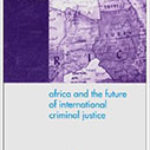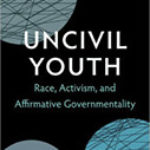I Ask for Justice: Maya Women, Dictators, and Crime in Guatemala, 1898-1944

Author: David Carey Jr.
Publisher: Austin, TX: University of Texas Press, 2013. 363p.
Reviewer: Gema Santamaría | September 2016
With an average homicide rate of nearly 40 murders per hundred thousand inhabitants, Guatemala is considered one of the most violent countries in Latin America today. Underpinned by various expressions of crime, including drug trafficking, juvenile gangs, vigilantism, and femicides, Guatemala’s current scenario is further complicated by pressing and persistent challenges to the rule of law. According to the 2014 Latin American Public Opinion Poll (LAPOP), on average, less than half of Guatemalans trust in the efficacy of the courts or in their justice system. Conversely, 62.8% of Guatemalans consider that the best means to counteract crime is for the state to impose harsher punishments of criminals. How to make sense of this apparent contradiction? How can distrust in the justice system be reconciled with people’s demands for more severe punishments, when the latter are to be administered by the very state institutions they do not trust?
Through a carefully crafted analysis of citizens’ encounters and interactions with crime, justice, and the law, historian David Carey Jr. offers a window into the particular and at times contradictory workings of authority and the legal system in twentieth- century Guatemala (1898-1944). By going beyond a functional interpretation of the justice system, Carey Jr. allows us to understand why even when lack of trust permeates state institutions, citizens may continue to appeal to them in order to ventilate social tensions and inter-personal conflicts. The reasons have to do with the manifold uses and effects that the justice and security apparatuses have had on the construction of gender, class, ethnicity, race, and national belonging in Guatemala. In this sense, and echoing historian and social thinker Michel Foucault, Carey Jr. demonstrates that state’s responses to crime are far from being merely a means to reduce crime. Instead, they constitute productive sites through which social understandings of justice and legitimacy are constantly both imagined and challenged.
I Ask for Justice makes three concrete contributions to the literature on crime and justice in Latin America. The first refers to the central and active role of the judicial system in the process of state formation in Guatemala. Despite being situated during the rule of two dictatorial regimes — those of Manuel Estrada Cabrera (1898-1920) and General Jorge Ubico (1931-1944) — the book demonstrates how the legal system in general and courts in particular were used by people from different social and economic backgrounds in order to advance their needs and demands. In a context riddled by economic exclusion and social discrimination, poor ladinos, landowners, peasants, and indigenous men and women alike, found through the courts and the legal system a common ground to express their grievances. As a result of this process, the state emerged as a central arbiter of social conflicts and was able to legitimate its authority in the eyes of citizens.
It was through the administration of justice that the Guatemalan state was able to further expand its presence at the local level. By establishing local rulings and regulations, state representatives found an opportunity to advance notions of progress, hygiene, propriety, and gender. While often informed by racist stereotypes, such notions were actively shaped and often contested by citizens within and outside the courts. For instance, indigenous litigants could bring into question officials’ racialized conceptions of deviancy by arguing that it was economic hardship, rather than ethnicity, that informed their violation of the law. As such, indigenous bootleggers would justify their clandestine production and selling of aguardiente or moonshine by pointing at their poverty and lack of alternatives to make a living through legal means. By the same token, indigenous female vendors would justify their violation of market regulations by appealing to their ignorance and marginality, rather than to their “traditions” or less so their ethnicity. These instances of negotiation between citizens and the state further confirm that, as explained by the author, Guatemala’s process of state formation was neither rigid nor one-sided but rather dynamic and relational.
The second contribution relates to Carey Jr.’s analysis of the workings of the justice system and of state institutions in twentieth-century Guatemala. In contrast to current media and scholarly discourses, which tend to relate Guatemala’s contemporary challenges to the “failure” or “weakness” of state institutions, I ask for Justice argues for a more nuanced and multifaceted understandings of the uses and effects of the country’s judicial system. In going beyond traditional measures of state efficacy (i.e. number of people indicted or sentenced), Carey Jr. highlights the role of state institutions as places of negotiation and contestation that enabled both citizens and state officials to produce a sense of citizenship, justice, and public order.
Weakened by the political elites’ patriarchal, discriminatory, and often arbitrary uses of the law, the justice system was nevertheless neither abandoned nor entirely rejected by citizens. Rather, the justice system’s arbitrariness contributed to a flexible and selective use of both the law as well as the state’s legal arena by Guatemalan citizens. Indigenous litigants would thus regard the state as a legitimate venue to ventilate their grievances and demands, a venue that could be used next to or in parallel to other extrajudicial methods. This partial functioning of the justice system ought not to be regarded as a sign of state failure, but rather a symptom of the partial, irregular and flexible character that was constitutive of state institutions in Guatemala. In this sense, the capacity of state institutions to integrate indigenous and rural populations depended less on the removal of alternative venues of justice, and more on its willingness to acknowledge — even if only implicitly — their existence and validity. Furthermore, the efficacy of the legal system was not necessarily contingent on the number of criminals convicted. Rather, its effectiveness rested upon its ability to serve as a legitimate arena of mediation and negotiation, even when crimes were not necessarily punished in legally effective or systematic manners.
Thirdly, I Ask for Justice offers a granular analysis of how the legal system shaped and was shaped by social constructions of gender, class, and ethnicity in Guatemala. By analyzing how indigenous working class women were able to use the legal system to place their demands and grievances, Carey Jr. contributes to advance our understanding of domination and patriarchy as processes that could and in fact became contested even by those who appeared to be the most vulnerable. Guatemalan’ public officials participated actively in the promotion and constitution of a patriarchal social order. By endorsing laws and regulations that reinforced women’s domesticity and subordination and by selectively punishing male over female violence, state representatives reinforced gender boundaries and buttressed a social order wherein women were regarded as passive and subordinated citizens.
Carey Jr. traces Guatemala’s “overlapping patriarchies,” which included a public arena that undermined women’s rights as well as a private sphere wherein inter-personal violence and even femicide were justified under gendered constructs. Rather than co-existing as two separate entities, the public and private spheres proved both reinforcing and instrumental for a regime that regarded violence against women as a potential outlet for working class men’s economic and political frustrations. Despite their exclusionary character, indigenous women were able to challenge these gendered dynamics by using the same justice system that served as the purveyor of patriarchal values. Enjoying a greater autonomy than Ladina women due to their economic and social status, indigenous women were able to use state institutions as a means to advance their interests. By appealing to shared notions of honor, vulnerability, and motherhood, indigenous women applied the legal system in order to denounce the injustices that impacted their lives at home and in the streets. In so doing, they were able to turn, even if only temporarily, patriarchal values on their heads, thus making women both legitimate bearers and subjects of justice that the Guatemalan modern state promised to deliver.
In 2015, Guatemala’s justice system surprised the world with the announcement that former dictator Efraín Ríos Montt could stand trial for genocide and crimes against humanity. The active role of the courts was seen as a departure from an otherwise failed and dysfunctional justice system. It also became a potential exemplar for other Latin American countries that have faced similar human rights violations and where perpetrators continue to remain unpunished. Nevertheless, for many observers, the possibility that the trial will not end in a sentence due to Ríos Montt’s dementia appears to confirm that impunity and injustice may continue to dominate Guatemala’s political and social landscape.
I Ask for Justice offers, however, a word of cautionary hope. The complex and at times contradictory history of crime and the law traced by Carey Jr. suggests that, in order to understand the workings of the justice system, we should look at its multiple functions and effects. If we understand the courts as spaces wherein notions of citizenship and justice are constructed and contested, then we should expect the process against Ríos Montt to have fundamental consequences for the way in which Guatemalan citizens understand their relationship towards those that have violated their rights. Resonating with a historical trajectory wherein Guatemalan citizens — including indigenous women — have been able to demand justice, Ríos Montt’s trial demonstrates that domination can be contested even when state institutions and the law are partial and defective.
Gema Santamaría, PhD, Assistant Professor, International Studies Department, Instituto Tecnológico Autónomo de México


